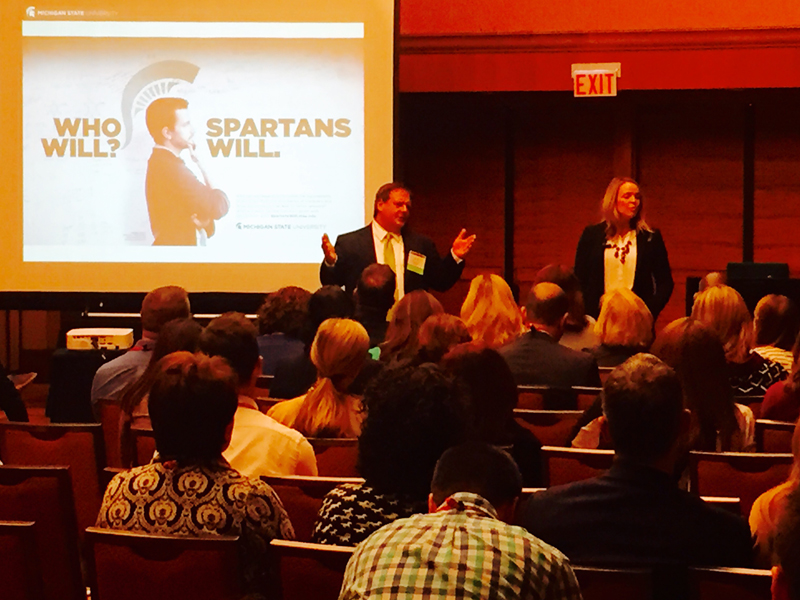AMA Higher Education Symposium Standouts
Education

The AMA Higher Education Symposium recently concluded. For agencies working within the higher ed space, this is a must-attend conference. This year, a record 1,300 attendees gathered in Chicago to meet, network, and learn about marketing within higher education. Several team members from BVK were at the event, and our own Account Planning Director Stephanie Barkow co-presented with Todd Carter, Assistant Vice President of Communications and Brand Strategy from Michigan State University. With so much involvement at the conference this year, we asked a couple of our BVK-ers to provide us with their insights and takeaways on this year’s conference.
Pat McGovern, Vice President, Account Services:
This year, the big win was having Stephanie co-present at the conference. This was a great opportunity to showcase our work and our knowledge within the higher ed industry. She did an amazing job representing the agency. And it was good to hear from both sides, how the work evolved and progressed from the concept to rollout. Sitting in the back, I was again reminded of the fact that in order for great work to happen, both sides need to be invested in the journey. In our case, we are fortunate to be working with such a good team at MSU.
As for takeaways, I heard three themes that helped drive success in the sessions I attended:
- Start with the why. For more on this idea go here. Organizations and leaders wanting to inspire and provide a sense of purpose and passion put the why first. And by doing this, it can help with the second take-away.
- Get internal buy-in. Getting the internal team “on the side of marketing” is not always an easy task, but those who took the time to connect and align with key stakeholders were able to move the needle.
- Focus. Many schools suffer from wanting to take on too much. When this happens, the result is nothing changes. But those schools that were able to focus on a key problem and had the discipline to say no to other issues saw the results they wanted.
Tam Powell, Sr. Vice President, Group Account Director:
I attended so many interesting sessions. One in particular was called “Flipping the Funnel.” The speakers shared one college’s strategy for increasing overall enrollments. Instead of focusing on adding more prospects at the top of the traditional funnel, they strove to better influence the prospects at the “inquiry” and “accepted” phases, toward the bottom of the funnel.
That particular case study indicated that with a mere 2% increase in the middle and lower stages of the funnel following inquiry, ultimately produced a double-digit (in this case 16%) increase in enrollment. This was accomplished by sending focused, personalized content to those who inquired — and was not from the admissions advisors. Instead, they sent material such as “Top 8 Tips for Organized Dorm Living” and other informational college tips. Further showing how content is critical in every recruitment strategy.
Another session focused on “Stealth Applicants: The Wave of the Future” which is a change to the traditional funnel, where more and more applicants are coming from outside the funnel altogether. It was estimated that for the Fall of 2015 semester, stealth applicants accounted for 62% of their college’s applications and 56% of overall enrollments.
So how are these applicants finding out about this college, then? According to the 2015 E-Expectations Report from Ruffalo Noel Levitz:
- 65% of high school juniors and seniors indicated a school’s website as the top way they research a school.
- Not surprisingly, an email from the school (13%) and calls from the admissions department (10%) where much further down the list.
How are these same applicants finding a college’s website?
- Search engines are most popular at 88% (with Google and Facebook listed as the top search engines used).
- 50% indicated an email link helped them find a college
- 38% said they knew the actual URL
- Only 25% indicated use of a college planning site to find a college
Other insights reminded us again of the importance of social media channels as a “must have” in our marketing strategies.
- 80% of their university’s Fall of 2015 stealth applicants followed them on at least one social media platform —mostly Facebook and Instagram.
- User-Generated Content (UGC) resulted in higher engagement with their applicants than the university-sponsored content.
- UGC was 35% more memorable and 50% more trusted than other types of information, with 56% of their stealth applicants following/reading the college’s student blogs.
Lastly was validating the importance of college website mobile compatibility. 70% of surveyed high school students have viewed a college website on their mobile device, including interaction with the site. Over 40% have actually requested information and even applied for enrollment using their mobile device!
All in all, it was a great conference with almost too much good information to take back and apply!